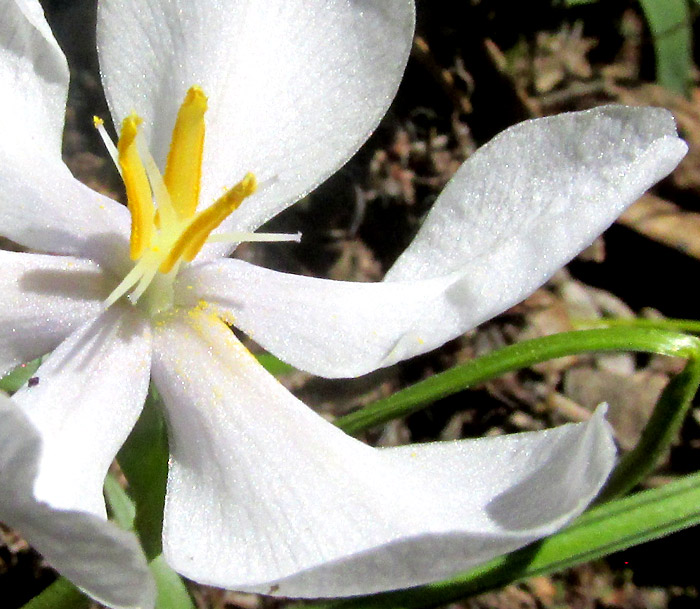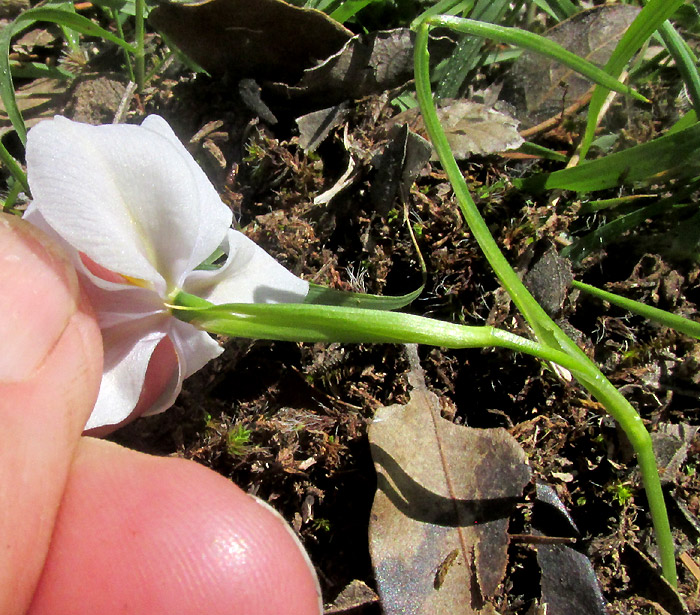Excerpts from Jim Conrad's
Naturalist Newsletter
Entry from field notes dated September 3, 2023, taken in Los Mármoles National Park in the Eastern Sierra Madre mountains, Hidalgo state, MÉXICO; oak-pine forested mountain, on road between Trancas {on maps designated "Morelos (Trancas)"} and Nicolás Flores, about 1.2km NW of Jagüey; limestone bedrock; elevation ~2,460m (~8,070); N20.808°, W99.237°
PLEATLEAF

Occupying a thin-soiled, eroded clearing next to an oak-pine forest, several of the above wildflowers were in different stages of flowering. In the above picture, note the crumpled flower at the left of the open blossom, its yellow stamens tightly twisting amid faded tepals. Tepals is the term used when a calyx's sepals aren't clearly different from the corolla's lobes or petals. Also, a good field mark seen is how the slender leaves are deeply creased, or pleated, down the middle, with the blades' sides folding toward one another.

At first I thought this would be one of many species of rain-flower, genus Zephyranthes, such as the Copper Zephyrlily seen earlier in central Mexico's altiplano semidesert scrublands. However, flowers of that group produce six stamens, while our blossoms bear only three. In the above photo, the stamens' three yellow, banana-like anthers are very conspicuous. Also in the above photo, note the confusing assembly of white, slender items stiffly radiating outward between the anthers. In this genus, a distinctive feature is that just a little above the ovary the slender style branches into three, and then each of those branches fork, producing two even slenderer, threadlike arms. Each of those six arms is tipped with a tiny stigma.

Above it's seen that the flower's bottom green part enlarges upward, indicating that it's an inferior ovary with tepals and stamens arising at its top. The flower emerges from a leaflike, folded-together spathe, reminiscent of iris blossoms.
The unusual style architecture and spathes take us to the genus Nemastylis, that name from the Greek nema, meaning thread, and stylos, referring to a pillar or rod, alluding to the threadlike style arms. Nemastylis, assigned to the Iris Family, the Iridaceae, is a small genus embracing only five species, all native just to North America, Mexico and Central America. In Hidalgo state here in highland central Mexico, only one Nemastylis has been documented, and that's NEMASTYLIS TENUIS.
Nemastylis tenuis occurs from drier upland parts of Arizona and western Texas in the US, south through Mexico's arid and semiarid highlands possibly as far south as the highlands of Honduras. In the US the plant may be known as the Southwestern Pleatleaf. However, this is much more a Mexican species than a US one, and in Mexico the "southwestern" part makes no sense, so I just call it Pleatleaf, a name applicable to all Nemastylis species. Some authors recognize five or so varieties or subspecies of Nemastylis tenuis, but Mexican experts insist that the subgroups grade into one another in our area, sometimes within the same population, so no sub-taxa are recognized.
I find no literature describing human uses of Nemastylis tenuis, though a gardening website suggests it for alpine gardening. The plant's flowers and leaves arise from a small bulb which probably is eaten by certain wildlife, and pollinators will visit the flower. This is just one of those obscure little species that appears briefly, offer to the broader ecosystem everything it has, and in the process produces a flower that is surprisingly pretty to humans.